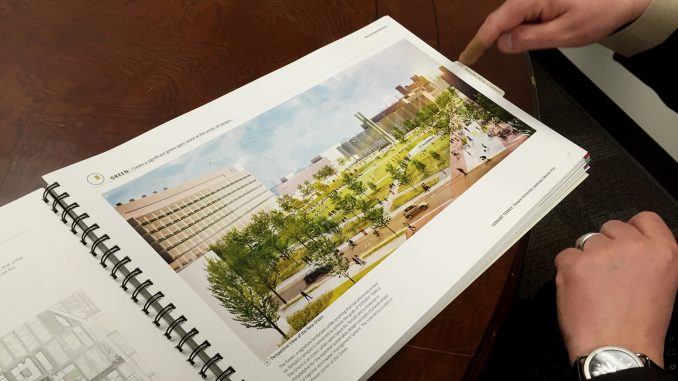
In the next few years, students can expect to see a lot more color on Main Campus.
Verdant Temple, Temple’s landscape development plan, aims to not only create more open green space on campus and reflect a more environmentally conscious school, but is also working to incorporate more public art on Main Campus, alongside landscape and architectural changes.
The 20-year master design plan includes an outlined strategy for the school’s first public art program, which calls for a dedicated committee that looks for new opportunities and spaces for art installations.
“Public art can take many different forms,” said James Templeton, director of architecture for the school’s project delivery group. “It can be a water fountain, it can be a statue or a sculpture or even something carved into a wall.”
The proposed program would build off about a dozen existing artworks on Main Campus, like the Bell Tower, the Red Owl marble sculpture at Alumni Circle and the bust of Russell H. Conwell in Founder’s Garden, working to restore and relocate some of the art pieces to more central locations on campus.
The master plan envisions an update to Columbia Plaza, the space on Cecil B. Moore Avenue near Broad Street where students and skateboarders congregate, including a refurbished sculpture and the creation of a performance space to showcase the school’s art and music programs.
Until an established public arts program comes to fruition on Main Campus that would have a dedicated committee, curator and policy to envision new projects, Templeton said Verdant Temple is working to incorporate more public art wherever possible as construction renovations continue.
“[Public art] would really help enliven a lot of our public spaces,” he said. “It could bring another layer of urban experience that you get in Center City with a lot of the public art, and bring it to the campus to help enliven and make spaces more inspirational.”
Senior visual studies major Chris Canan said a public arts program could only be positive for Main Campus.
“Whether it’s just a painted square … or some huge mural, it will cause you to stop and think outside of your normal routine,” he said. “We are so structured, we are so in this routine and to see something out of the ordinary in places where you don’t expect, or places where you do expect…it really serves to break up monotony.”
Under the proposed plan, the installation “Hurry,” created by William Dickey King in 1981, will be relocated from its spot on Beury Beach to a green space closer to the Temple University Regional Rail station at 10th and Berks streets. The ceramic tile mural created by Raymond Gallucci, which currently resides in Ritter Hall, will be moved either to Liacouras or Polett Walk, and the now-damaged steel sculpture “Triad” outside of Johnson & Hardwick halls, would be removed altogether.
Templeton said the University of Pennsylvania and its extensive public art collection, which includes 72 pieces on campus, are an inspiration for public art at Temple.
Hopefully, Templeton said, Temple can continue this “tradition” of public art in Philadelphia by creating various types of art installations, from small works in courtyards, to temporary installations by Tyler students, to even larger, monumental works that would serve as symbols of the school, he said.
Installations will be designed and planned, Templeton said, as each new renovation project gets underway. This includes the anticipated Campus Green, the proposed quad-like green space bounded by Polett Walk and Norris, 12th and 13th streets, which will become one of the largest urban green spaces in the city.
“It would really be a wonderful addition to our campus,” Templeton added. “Since it’s so urban and landlocked it would be this nice retreat from the urban grid that we’re always fighting on campus.”
Templeton views the addition of art to the campus renovations as bringing a “third layer of intrigue” to the public green spaces on top of the landscape and architecture.
As a way of building more connections between Temple and the city, Templeton suggested a collaborative art installation between the school and SEPTA, which would design a work of public art to help integrate the Temple University Regional Rail station.
“There’s a lot going on outside our walls,” said Canan, who said he wonders if public art could create more participation between Temple students and community residents. “There’s little communities around that could really get involved around here.”
“[Public art] is usually a good way to start a conversation,” he added. “It would be a good avenue to start improving that kind of relationship.”
Emily Thomas can be reached at emily.ralsten.thomas@temple.edu.


Be the first to comment